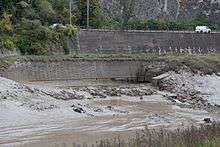Northern Stormwater Interceptor, Bristol
The Northern Storm Water Interceptor (NSWI), is a large stormwater tunnel that acts as a flood prevention measure for Bristol, England.

Building of the storm drain started in 1951 to relieve flooding over many parts of Bristol, and was completed in 1962.[1] It is some 4–5 metres in diameter and runs from the River Frome at Eastville to the Black Rocks Quarry in the Avon Gorge.[2][3] Originally proposed by the County Surveyors Frederick Ashmead and Col T H Yabbicom in the 1890s, due to the Great War, the Depression and the Second World War, construction was postponed until 1951. The scheme was reborn after the floods in Bristol 1947. The Tunnel was designed by Bristol City Engineers including Peter Steele and Bernard Smission from 1947. The tunnel was blasted through Limestone, Dolimitic Conglomerate and Keuper Marl and lined with a 375mm thick concrete lining. At its deepest the tunnel is 90 metres deep.
Smission invented the Energy Dissipating Vortex Drop Pipe System of which two were constructed along the tunnel. The technology has since been used in Chicago, New York and closer to home in Plymouth.[4]
The future management of flooding risk in the Eastville area is under consideration.[5]
References
- "Northern Storm-water Interceptor". Nettleden. Retrieved 29 October 2016.
- Begun, Selina; Stive, Marcel J.F. (2007). Flood Risk Management in Europe: Innovation in Policy and Practice. Springer Science & Business Media. pp. 216–219. ISBN 9781402042003.
- "Bristol Floating Harbour Recreational Water Profile". Bristol City Council. Retrieved 29 October 2016.
- "Bristol City Council: Pollution control – water: Bristol Living Rivers Project – Waterways Monitoring". www.bristol.gov.uk. Retrieved 26 May 2009.
- "Bristol Frome Flood Management Strategy" (PDF). Atkins. Retrieved 23 November 2018.
External links
- Nettleden – The Motherload, Bristol
- "NSI map - Nettleden.com". www.nettleden.com. Retrieved 17 September 2009. Map